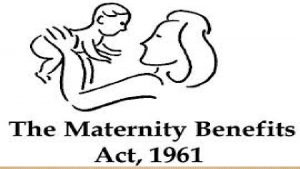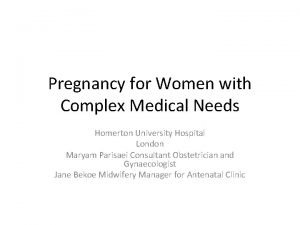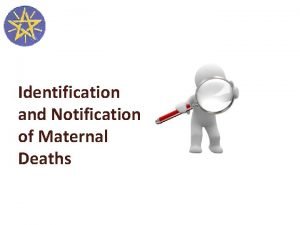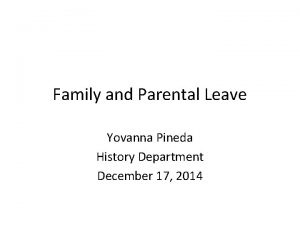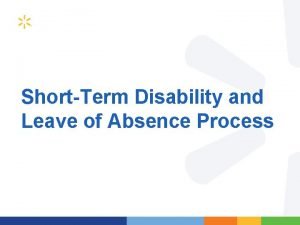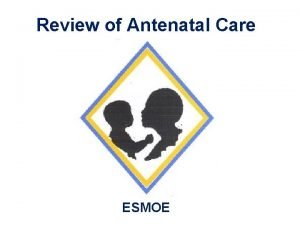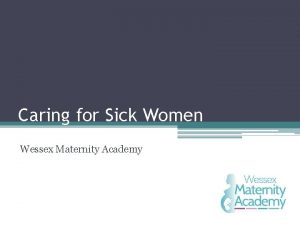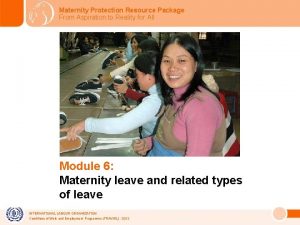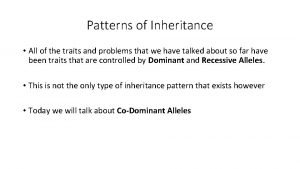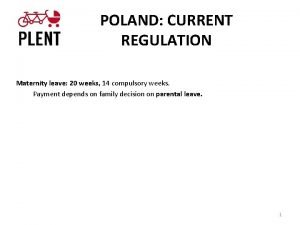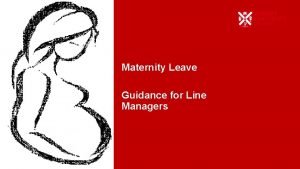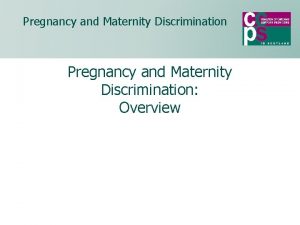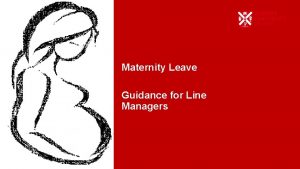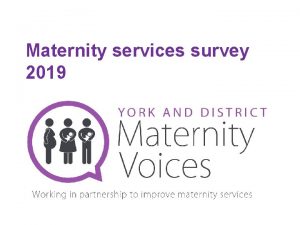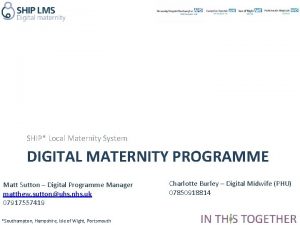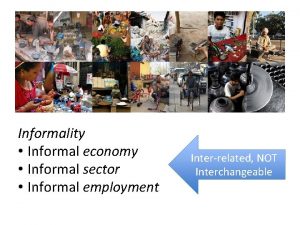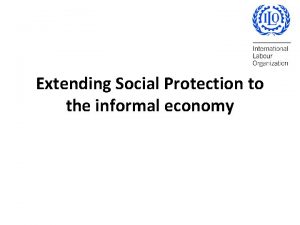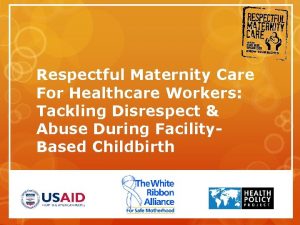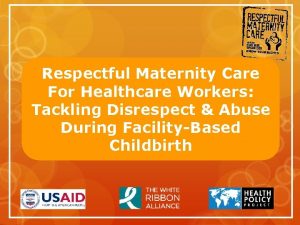Extending maternity protection to informal workers in Viet



















- Slides: 19

Extending maternity protection to informal workers in Viet Nam Silke Steinhilber, International Consultant, UN Women & ILO with Nguyen Hong Dieu

Structure of the presentation 1. Context maternity protection Viet Nam 2. Global policy norms on maternity protection 3. Options and approaches to extending maternity protection to informal workers: Global experiences and options for Viet Nam

National context Viet Nam • Contrast Øgenerous maternity benefits in statutory scheme Øno benefits in voluntary scheme • Coverage gap: majority of women workers do not enjoy maternity benefits Øabout 7. 8 million women informal workers Øvery limited participation in voluntary social insurance Øno maternity benefits so far, only long-term benefits

Policy context Viet Nam • Governmental commitment to enhancing social security ØMaster Plan for Social Protection Reform ØResolution 28 on extending coverage ØArt. 13 Gender Equality Law • Extending coverage of social insurance, current discussion: ØExpanding benefits in voluntary insurance scheme, esp. short term benefits (e. g. maternity, work accident) ØBoosting number of people in voluntary insurance scheme

Global norms on maternity protection • ILO Maternity Protection Convention, 2000 (No. 183); ILO Social Security (Minimum Standards) Convention, 1952 (No. 102) – not ratified by Viet Nam • Maternity protection should apply to all women, including those working under informal conditions. • Maternity protection at work entails five components: 1. maternity leave, 2. cash and medical benefits, 3. health protection: workplace health and safety for a mother and child, 4. employment protection and non-discrimination, 5. breastfeeding support

Extending maternity protection globally • Most countries have maternity protection legislation (incl. 50% of low-income countries) • Usually protection applies to formal economy only. 2014: only 28. 4 per cent of employed women expected maternity cash benefits (ILO) • Need to extend coverage • Two main strategies for extending benefits globally: Øextending contribution-based schemes Øproviding for non-contributory cash transfers

Extending maternity benefits: global trends & Vietnamese reality • Viet Nam: Ø 2014: extension of statutory scheme to workers with min. 1 month contract Ø 2015: Decree 39/2015/ND-CP, support to ethnic minority women giving birth • How to further extend benefits, given the significant coverage gaps? Øproviding maternity benefits through voluntary scheme? Ømulti-tier extension? Øbenefit design? (ILO C 183 as guiding framework)

Extending benefits through voluntary insurance • Short-term benefits in voluntary scheme as a way to incentivize membership • Acknowledgement of women’s (informal) work: income replacement as way toward women’s economic empowerment • Limited contributory capacity of women informal workers, reliance on subsidies, sustainability of the scheme?

Extending benefits through voluntary insurance • Problem of self-selection / risk pooling: need to combine maternity benefits with other short-term benefit to attract women and men of different ages • No opting out: maternity is social responsibility, not individual risk • Benefit design: focus on cash benefit (what about the other aspects of maternity protection? ); length of payment; level of benefit; qualifying periods

Extending benefits through voluntary insurance • Few examples globally, long-term impact not studied • Mongolia: Øcombination of statutory, voluntary, non-contributory pillars Ølimited benefit from voluntary scheme combined with non-contributory benefit Øfinancing: state budget, from mineral and mining revenues Ønearly full coverage achieved

Extending benefits through voluntary insurance • Namibia: Øcombination of statutory and voluntary scheme Øcompulsory for domestic workers and employees of small enterprises Øvoluntary for self-employed, no subsidies Øcoverage gap: 43% of women workers excluded • No comparison between cost of subsidizing voluntary schemes and financing non-contributory maternity benefits available

Extension through non-contributory schemes • Predictable cash support during final stages of pregnancy and after childbirth • Support for motherhood, regardless of employment situation • Coverage of women with no / very low contributory capacities • Financing from state budget necessary • Viet Nam: benefit for women from ethnic minorities

Extension through non-contributory schemes • Examples of conditional cash transfers globally (often not limited to maternity) • Financing often not from regular state budget (e. g. external funds, temporary funds) • India: worker welfare funds; conditional cash transfer schemes; some combine worker contributions and levies on value of production

Group-specific extension efforts • Numerous examples globally, focusing on inclusion of domestic workers in statutory social insurance (Latin America, some Africa and Asia) • Inclusion of self-employed • Inclusion of seasonal and part-time workers and workers with multiple employers

Additional considerations for extension of maternity benefits • Who is in greatest need? How can specific groups be best included? - rural women - ethnic minority women - young urban women (shop assistants, domestic workers) - migrant women workers • What are the preferences of informally working women/families ?

Additional considerations for extension of maternity benefits • which groups of women informal workers most affected • demographic, health and labour market data not aligned • challenge for actuarial calculations and modelling • patterns over life-cycle • Cost calculations only feasible with assumptions about benefit design and new beneficiaries

Additional considerations for extension of maternity benefits • Maternity protection to be seen in connection with other gender-specific barriers in employment / social protection, e. g. Øwage/income gap in informal economy Øpatterns of women’s informal work over life cycle Øhigh share of unpaid female contributing family workers Øgender-specific differences in information, mobility, interaction with social security administration

Additional considerations for extension of maternity benefits • Maternity protection goes beyond cash benefits • Maternity protection is women-specific, but childbearing and care work are not – revisiting of gender roles, work-family reconciliation policies necessary

Thank you
 Nhất nam viết hữu thập nữ viết vô
Nhất nam viết hữu thập nữ viết vô Maternity bitmoji
Maternity bitmoji Legislation related to maternity benefits
Legislation related to maternity benefits Homerton maternity helpline
Homerton maternity helpline Woman within maternity
Woman within maternity Obstetrics score
Obstetrics score Maternity benefit act 1961 notes
Maternity benefit act 1961 notes Objectives of maternity ward
Objectives of maternity ward Almada negreiros maternity
Almada negreiros maternity Ut austin maternity leave
Ut austin maternity leave Sedgwick walmart
Sedgwick walmart Maternity clinic card
Maternity clinic card Wessex maternity academy
Wessex maternity academy Why is maternity leave important
Why is maternity leave important Ar 600-8-10 maternity leave
Ar 600-8-10 maternity leave There is a practical joker in the maternity ward
There is a practical joker in the maternity ward Maternity leave poland
Maternity leave poland X bar theory exercises with answers pdf
X bar theory exercises with answers pdf Parallelogram desk
Parallelogram desk Double bond extending conjugation
Double bond extending conjugation


